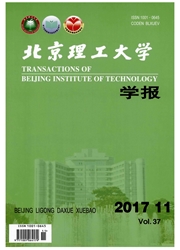

 中文摘要:
中文摘要:
为研究活性破片战斗部爆炸驱动作用行为,采用数值模拟与试验相结合的方法,获得了缓冲层材料及厚度对活性破片战斗部爆炸驱动行为的影响特性.数值模拟结果表明,随着缓冲层厚度的增加,活性破片飞散速度明显降低,4种缓冲材料中,软铝缓冲层对活性破片初速影响最大,且破片初速随缓冲层厚度的增加基本呈线性下降趋势,尼龙和凯夫拉缓冲层对破片初速影响较小;随着缓冲层厚度的增加,活性破片所受载荷明显降低,其中软铝降载荷效果最好,其次为凯夫拉.综合考虑活性破片速度和破片完整性、安定性要求,选择凯夫拉缓冲层较好.最后,通过活性破片战斗部地面静爆试验对数值模拟结果有效性进行了验证,试验结果表明,数值模拟结果与试验结果吻合较好.
 英文摘要:
英文摘要:
The influence of buffer material and layer thickness on explosive driven behaviors of reactive fragment warhead has been researched using combined approach of numerical simulation and experiments. The numerical results demonstrate that the value of initial velocity decreases significantly with the increase of the thickness of buffer layer. For the same thickness, the buffer layer made from annealed aluminum has the greatest effect on the initial velocity decrease of reactive fragment being close to a linear decrease trend, while the buffer with nylon and Kevlar material gives a smaller effect. The magnitude of load of reactive fragment subject to detonation waves decrease evidently with the increase of the thickness of buffer layer. For the same thickness, the buffer layer made from annealed aluminum has the best effect and the buffer with Kevlar material shows a secondary best effect. Considering comprehensively the initial velocity and the integrity of reactive, it is suggested that the buffer layer made from Kevlar material be optimal. The explosion experiments of reactive fragment warhead were conducted and the test results agreed well with the results of numerical simulation showing the validity of the numerical approach.
 同期刊论文项目
同期刊论文项目
 同项目期刊论文
同项目期刊论文
 期刊信息
期刊信息
